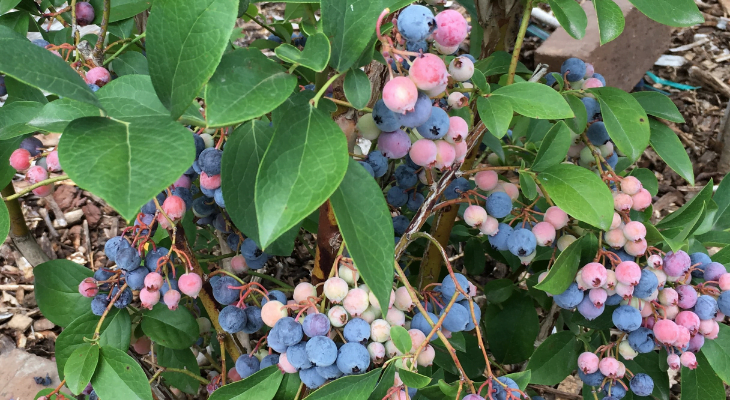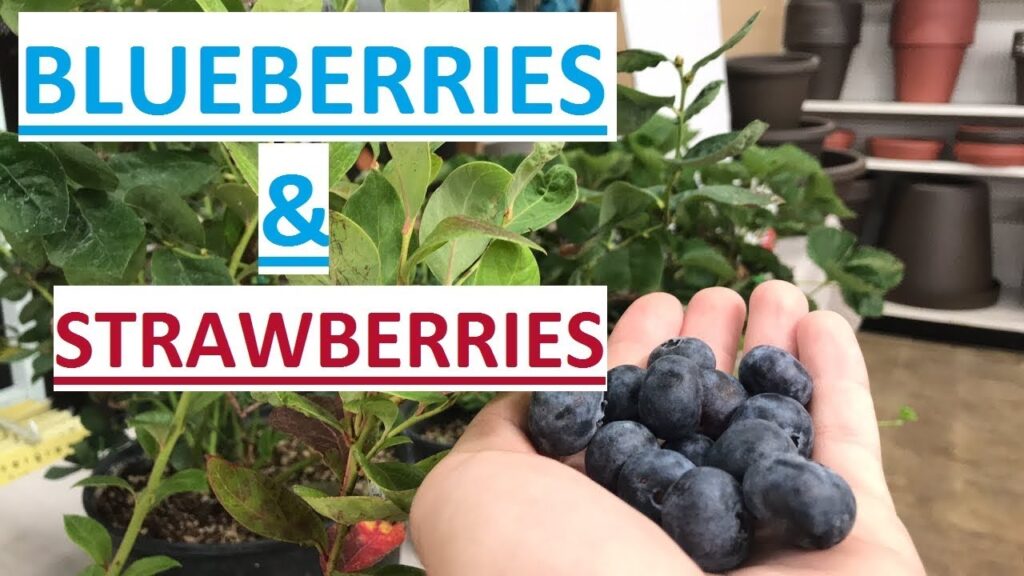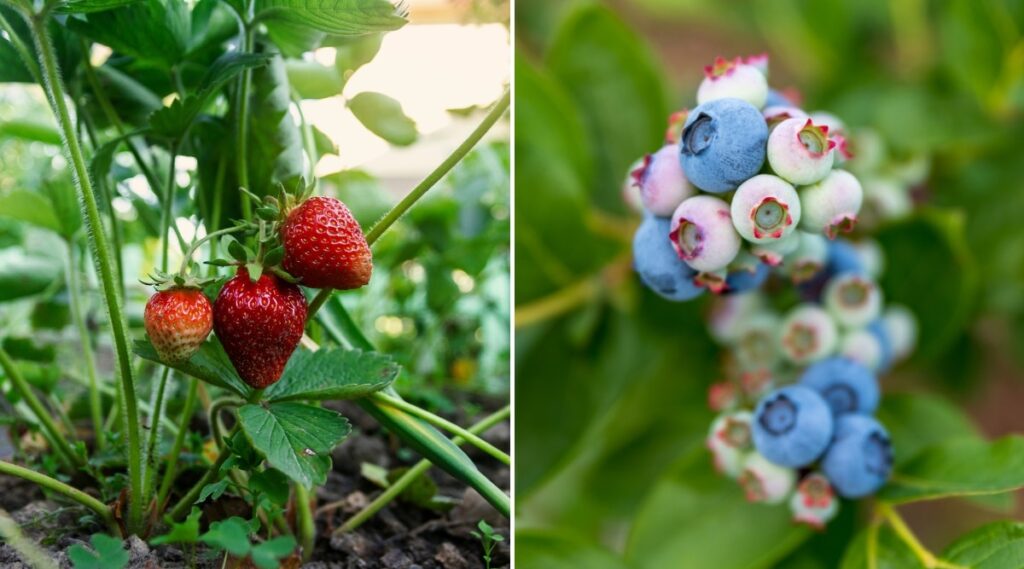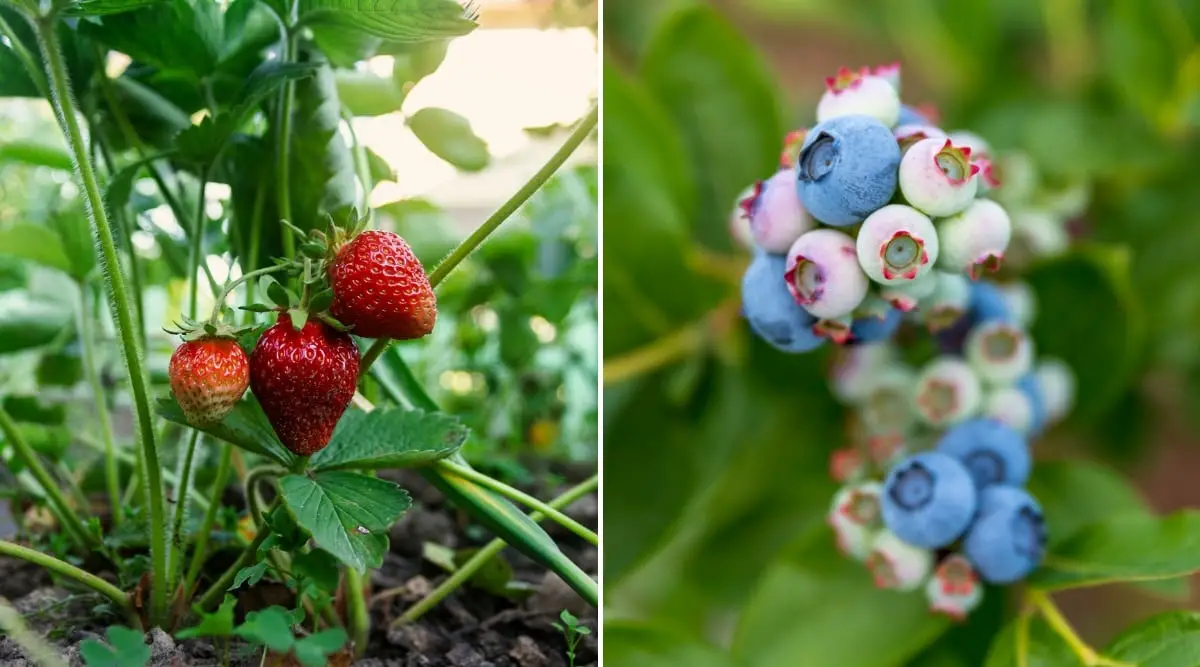Planting blueberries and strawberries together may seem like a delightful idea, as the combination promises a colorful and delicious garden. However, before embarking on this horticultural adventure, it is crucial to consider the compatibility of these two fruits. Both blueberries and strawberries have distinct soil requirements, nutrient preferences, and growth habits. Therefore, understanding the intricacies of each plant’s needs is imperative to ensure a successful coexistence. In this article, we will explore whether it is feasible to plant blueberries and strawberries together, and provide expert insights on the best practices to create a harmonious berry patch in your garden.

Choosing the Right Location
Sunlight Requirements
When choosing a location for planting blueberries and strawberries, it is important to consider the sunlight requirements of these plants. Both blueberries and strawberries thrive in full sunlight, which is defined as at least six hours of direct sunlight per day. Adequate sunlight is necessary for proper growth, flowering, and fruit production of these plants. Therefore, it is essential to select a location that receives ample sunlight throughout the day to ensure the success of your blueberry and strawberry plants.
Soil Conditions
The soil conditions play a crucial role in the growth and development of blueberries and strawberries. Both of these plants prefer well-drained soil that is rich in organic matter. Blueberries require acidic soil with a pH range of 4.0 to 5.0, while strawberries prefer slightly acidic soil with a pH range of 5.5 to 6.8. Conducting a soil test before planting will help determine the pH level and nutrient content of the soil. It is important to choose a location with soil that can be easily amended to fit the specific requirements of blueberries and strawberries.
Hydroponic Systems
Another option for growing blueberries and strawberries is through hydroponic systems. Hydroponics is a method of growing plants without soil, using nutrient-rich water solutions. This method allows for greater control over the growing conditions and eliminates the need for traditional soil-based cultivation. Hydroponic systems provide an efficient way to grow blueberries and strawberries, especially in areas with limited space or poor soil quality. However, setting up and maintaining a hydroponic system requires specialized knowledge and equipment.
Preparing the Soil
Soil pH
Before planting blueberries and strawberries, it is important to adjust the soil pH to suit the specific needs of these plants. Blueberries require acidic soil, so if your soil pH is too high, you will need to lower it by adding soil amendments. Conversely, if your soil pH is too low, you can increase it by incorporating lime. Testing the soil pH and making the necessary adjustments will create an optimal growing environment for blueberries and strawberries, ensuring that they can absorb nutrients efficiently and thrive.
Soil Amendments
In addition to adjusting the soil pH, incorporating organic matter and other soil amendments can greatly improve the soil conditions for blueberries and strawberries. Organic matter, such as compost or well-rotted manure, helps improve soil structure, drainage, and nutrient availability. Adding organic matter promotes beneficial microbial activity in the soil, which aids in nutrient uptake by the plants. Additionally, you can include other soil amendments like peat moss or perlite, depending on your specific soil composition and needs.
Creating Raised Beds
Creating raised beds is a popular method of growing blueberries and strawberries, especially if the native soil is not ideal for these plants or if you have limited gardening space. Raised beds provide better control over soil conditions, including pH and drainage. They also help prevent soil erosion and provide good air circulation around the plants. When constructing raised beds, it is important to use materials that are safe for the plants and will not leach harmful chemicals into the soil, such as untreated cedar or cypress.

Planting Blueberries and Strawberries
Planting Blueberries
When planting blueberries, it is important to consider several factors to ensure successful establishment and growth. Blueberries are typically sold as bare-root or container-grown plants. Before planting, make sure to soak bare-root plants in water for a few hours to rehydrate their roots. Dig a hole for each plant that is wide and deep enough to accommodate its root system. Blueberries should be planted at the same depth they were grown in the nursery. After planting, water thoroughly and apply a layer of mulch around the plants to conserve moisture and suppress weed growth.
Planting Strawberries
Strawberries can be planted as bare-root plants or as transplants from small pots. Before planting, carefully separate the strawberry runners from the main plants to ensure better growth and fruit production. Dig a hole that is wide and deep enough to accommodate the plant’s root system, leaving the crown just above the soil surface. Spread the roots out in the hole and backfill with soil, gently firming it around the plant. Water the newly planted strawberry plants immediately and continue to keep the soil moist throughout the growing season.
Companion Planting
Companion planting is the practice of growing different plants in close proximity to take advantage of their mutually beneficial relationships. While blueberries and strawberries are compatible with a range of plants, certain companion plants can enhance their growth and productivity. For example, planting borage near strawberries can attract pollinators and deter pests, while interplanting clover between blueberry bushes can provide nitrogen fixation and improve soil fertility. However, it is important to research and select companion plants that are compatible with blueberries and strawberries to avoid any potential negative interactions.
Caring for Blueberries and Strawberries
Watering
Proper watering is crucial for the healthy growth and development of blueberries and strawberries. Both plants require consistent moisture, especially during the fruiting season. Adequate water supply promotes fruit development and helps prevent various issues such as fruit cracking or drying out. However, overwatering can lead to root rot and other diseases, so it is important to strike a balance. Regularly monitor soil moisture levels and provide enough water to keep the soil evenly moist but not waterlogged.
Mulching
Mulching is an essential practice for maintaining the health and productivity of blueberries and strawberries. Mulch helps conserve soil moisture, suppress weed growth, and regulate soil temperature. It also acts as a natural barrier, preventing soil erosion and protecting the plant’s root system. When mulching blueberries, use materials such as pine needles, wood chips, or sawdust to help maintain the desired level of soil acidity. For strawberries, straw or shredded leaves are commonly used mulching materials to keep the fruits clean and off the soil.
Pruning
Pruning is an important maintenance practice that helps shape the growth of blueberries and strawberries, encourages fruit production, and rejuvenates older plants. Blueberries should be pruned during the dormant season, generally in late winter or early spring, before the new growth begins. Remove any dead, damaged, or low-hanging branches, as well as any thin or weak growth. For strawberries, it is recommended to remove runners and excess leaves to direct energy towards fruit production. Regular pruning allows for better air circulation and light penetration, reducing the risk of diseases and improving overall plant health.

Fertilizing
Blueberry Fertilization
Blueberries have specific nutrient requirements that need to be met for optimal growth and fruit production. Before fertilizing, it is important to conduct a soil test to determine the nutrient levels and pH of the soil. Based on the test results, you can adjust the soil pH if needed and determine the appropriate fertilization strategy. Blueberries generally require a balanced acidic fertilizer, such as a 10-10-10 or 12-12-12 formula. Additionally, incorporating organic fertilizers like composted manure or fish emulsion can provide a slow-release supply of nutrients throughout the growing season.
Strawberry Fertilization
Strawberries also have specific nutrient requirements that should be met for healthy growth and abundant fruiting. Before fertilizing, it is advisable to conduct a soil test to assess the nutrient levels and pH of the soil. Based on the results, you can adjust the soil pH if necessary and determine the appropriate fertilization plan. Strawberries generally require a balanced fertilizer with equal amounts of nitrogen, phosphorus, and potassium, such as a 10-10-10 or 12-12-12 formula. Applying a slow-release fertilizer during the growing season will provide a continuous supply of nutrients to the plants.
Fertilizer Compatibility
When using fertilizers on both blueberries and strawberries, it is important to consider their compatibility to avoid any negative interactions or nutrient imbalances. Blueberries and strawberries have different nutrient requirements, so it is advisable to fertilize them separately, taking into account their unique preferences. Applying compatible fertilizers at the appropriate times and rates will ensure that both plants receive the necessary nutrients without causing any harm. It is important to carefully follow the instructions provided with the chosen fertilizers and consult with local agricultural extension services for specific recommendations.
Controlling Pests and Diseases
Common Blueberry Pests
Blueberries can be susceptible to various pests, including blueberry maggot, aphids, mites, and fruitworms. To control these pests, it is important to implement integrated pest management (IPM) strategies that include both cultural and chemical methods. Cultural practices such as regular inspection, proper sanitation, and removal of affected plant parts can help prevent pest infestations. Natural predators and beneficial insects can also be encouraged to control pests. If chemical control becomes necessary, it is important to choose products labeled for use on blueberries and follow the instructions carefully.
Common Strawberry Pests
Strawberries can be affected by pests such as strawberry weevils, slugs, aphids, and spider mites. Similar to blueberries, integrated pest management techniques should be utilized to effectively manage these pests. Cultural practices, including proper spacing, weed control, and removal of damaged plants, can help prevent pest infestations. Physical barriers, such as row covers, can provide protection against larger pests. Additionally, attracting beneficial insects, like ladybugs and lacewings, can aid in controlling pest populations. If chemical control is necessary, choose products labeled for use on strawberries and follow the recommended application rates and timing.
Disease Prevention
Blueberries and strawberries are susceptible to certain diseases, including powdery mildew, gray mold, and leaf spot. Disease prevention is key to maintaining the health of these plants and preventing crop losses. Implementing cultural practices such as proper sanitation, good air circulation, and regular removal of affected plant parts can help prevent the spread of diseases. Avoid planting blueberries and strawberries in areas previously affected by disease to minimize the risk of recurrence. If necessary, fungicides labeled for use on these plants can be applied according to the instructions to prevent or control disease outbreaks.

Harvesting and Storage
Blueberry Harvesting
Blueberries are typically ready for harvest when they develop their characteristic blue color and can easily be detached from the plant. The berries should be firm and plump, with a sweet taste. Gently grasp the berry between your fingers and gently twist it to detach it from the stem. Harvesting should be done during cool mornings or evenings to minimize heat stress on the berries. Place the harvested blueberries in a shallow container to avoid crushing or bruising, and refrigerate them promptly for optimal freshness and shelf life.
Strawberry Harvesting
Strawberries should be harvested when they are fully red, firm, and fully ripe. To pick strawberries, gently twist the fruit while holding the stem to detach it from the plant. Avoid pulling on the berries, as it can damage the plant or neighboring fruits. It is best to harvest strawberries in the early morning when the temperatures are cooler to maintain their quality and prevent fungal growth. Immediately after harvesting, refrigerate the strawberries to preserve their flavor and extend their shelf life. Avoid washing them until just before consumption to prevent premature spoilage.
Storage Tips
To maximize the storage life of both blueberries and strawberries, it is important to handle them properly and store them under optimal conditions. Blueberries can be stored in the refrigerator for up to two weeks if kept dry and in a sealed container. If you are not planning to consume them immediately, blueberries can also be frozen for longer-term storage. Wash and dry strawberries before refrigerating them, as excess moisture can lead to spoilage. Strawberries should be consumed within a few days of harvest for the best flavor and quality.
Growing Blueberries and Strawberries in Containers
Choosing the Right Container
Growing blueberries and strawberries in containers allows for greater flexibility and portability, making them suitable for small spaces or urban gardening. When selecting containers, choose ones that are large enough to accommodate the root systems of the plants and provide adequate drainage. It is recommended to use containers made of durable, UV-resistant materials to withstand outdoor conditions. Options include plastic, ceramic, or terracotta pots. Additionally, ensure that the container has drainage holes at the bottom to prevent waterlogging and root rot.
Potting Mix
Selecting the appropriate potting mix is crucial for successful container gardening of blueberries and strawberries. A well-draining mix specifically formulated for acidic-loving plants is ideal. The potting mix should be able to retain moisture while providing good drainage to prevent waterlogging. It is advisable to avoid using garden soil alone, as it may compact and hinder root growth. Instead, opt for a commercially available potting mix that contains a blend of organic matter, perlite, and vermiculite. Adding organic matter like compost or peat moss can further improve the nutrient content and water-holding capacity of the potting mix.
Watering and Fertilizing
Container-grown blueberries and strawberries require special attention to watering and fertilizing to ensure healthy growth and abundant yields. Due to the limited soil volume, containers tend to dry out faster, so it is important to monitor soil moisture levels regularly. Water deeply whenever the top inch of the soil becomes dry, ensuring that excess water drains out of the container. Fertilize container-grown blueberries and strawberries with a balanced acidic fertilizer according to the recommended rates and schedule. Applying organic fertilizers like compost or fish emulsion can also provide additional nutrients and promote healthy growth.

Troubleshooting Common Issues
Yellowing Leaves
Yellowing leaves in blueberries and strawberries can be an indication of nutrient deficiencies, pest infestations, or improper soil pH. Conducting a soil test can help identify any nutrient imbalances and adjust the soil pH if necessary. If pests are causing the yellowing leaves, implementing integrated pest management strategies can help control their populations. Additionally, ensure that the plants are getting enough sunlight and are not overcrowded, as poor air circulation can contribute to yellowing leaves. Proper watering and fertilization practices can also help alleviate leaf discoloration.
Poor Fruit Production
Poor fruit production in blueberries and strawberries can be attributed to various factors. Insufficient sunlight, improper pollination, nutrient deficiencies, or inadequate watering can all contribute to poor fruit set. Ensure that the plants are receiving at least six hours of direct sunlight per day and that they are not shaded by surrounding vegetation. Encouraging pollinators, such as bees and butterflies, can improve fruit set. Adequate watering and proper fertilization with balanced fertilizers can also promote healthy plant growth and fruit production. Additionally, timely pruning and disease prevention measures can help optimize fruit yield.
Lack of Pollination
A lack of pollination can result in poor fruit set in both blueberries and strawberries. These plants rely on pollinators, predominantly bees, to transfer pollen from the male to the female flower parts. If pollinators are scarce or the weather conditions are unfavorable for pollination, hand pollination can be performed. Gently transfer the pollen from the stamen of a male flower to the stigma of a female flower using a small brush or cotton swab. Repeat this process for each flower to ensure proper pollination and subsequent fruit development.
Conclusion
In conclusion, planting blueberries and strawberries requires careful consideration of various factors, from selecting the right location to meeting the specific needs of these plants. Sunlight requirements, soil conditions, and hydroponic systems are all aspects to consider when deciding where to grow blueberries and strawberries. Preparing the soil, planting, and caring for these plants involve activities such as adjusting soil pH, incorporating soil amendments, creating raised beds, and ensuring proper watering, mulching, and pruning. Fertilizing blueberries and strawberries, controlling pests and diseases, and understanding the importance of harvesting and storage are also crucial for successful cultivation. Additionally, growing blueberries and strawberries in containers offers a flexible and portable option, while troubleshooting common issues helps address potential problems. By following these guidelines and best practices, you can enjoy the sweet and nutritious fruits of your labor in cultivating blueberries and strawberries.



